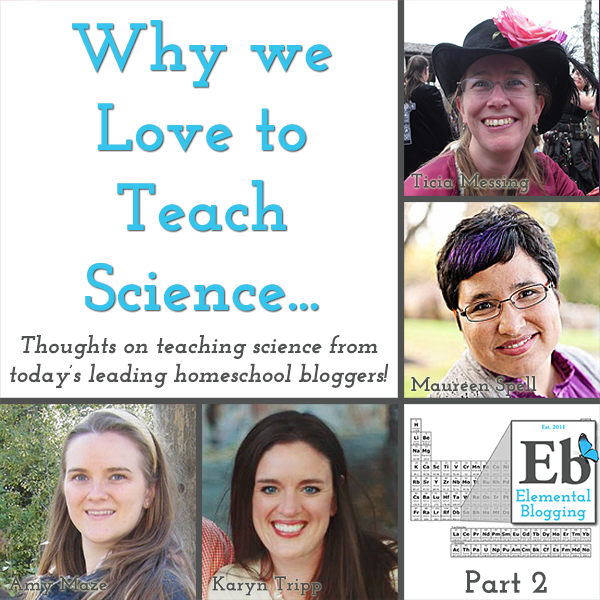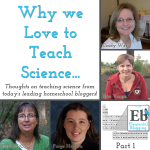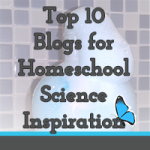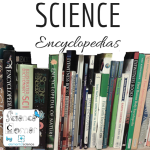I love to hear about how other homeschoolers teach certain subjects, even science. I find it so inspiring to look at teaching from a different perspective. This is why I have set out to gather thoughts on teaching homeschool science from some of today’s leading bloggers.
This month, I’ve asked Karyn, Ticia, Maureen, and Amy to share their thoughts. Thank you ladies for offering your perspective on why you love to teach science!

WHY WE LOVE TO TEACH HOMESCHOOL SCIENCE
Karyn Tripp
Student Ages – newborn, 3, 6, and 9
Years Homeschooling – 7 years
Methods – Eclectic, influenced by Charlotte Mason & Thomas Jefferson Education
Blog – Teach Beside Me
You can also connect with Karyn through Facebook and Twitter.
I did not enjoy science very much when I was in school, especially in the older grades. I think one of the things I love about homeschooling my kids is that I get to learn things all over again. I love teaching science to my kids because I love seeing the excitement on my kids’ faces when we discover new things. I love answering their questions and inquiries about life. We love to study nature, do hands-on experiments, and read living books about science topics. My kids love learning about animals, so we visit the zoo and petting zoo a lot.
Science is one of my favorite subjects to teach, well science and history. I have 3 very hands on learners and science is an easy subject to get my kids excited about. It’s a very visual subject, and one that is easy to adapt to hands on learning. We’ve gone outside and measured ourselves against whales (we are much smaller in case you’re wondering), and made models of the heart for anatomy. We’ve gone tromping through local parks looking for animal tracks, and stopped to look at the cool things we’ve discovered. There’s nothing more exciting than to hear your child come running up to you, “Mommy, what is this? How can we find out?”
You know what’s the absolute best, though? When you can bring in other studies with your science. Learning about multiple subject areas at the same time. I’ve gotten the most impact when we can integrate science and math or science and history. That’s when homeschooling is golden. The moment they see how several things interact together.
Maureen Spell
Student Ages – 1, 3, 5, 7, 12, 14, and 15
Years Homeschooling – 12 years
Methods – Charlotte Mason, Eclectic
Blog – Spell Outloud
You can also connect with Maureen through Facebook, Google+, Twitter, and Pinterest.
As a young girl I always loved the hands-on nature of science and was sorely disappointed when we didn’t do labs or experiments in class. I wanted more than just reading things in a textbook—- I wanted to experience science!
Once I started teaching my own children, I wanted to bring that excitement into our science lessons. The easiest way was to incorporate nature studies into our routine. Nature study works for all ages, is hands-on, and can be done as a family. It’s also a great way to get outside, explore, and build background information for later science studies. Though we might use different science tools over the years, the one constant thing has been our love for nature studies and hands-on science projects.
Amy Maze
Student Ages – 4 and 5
Years Homeschooling – 2 years
Methods – Classical
Blog – Living and Learning at Home (Don’t miss the classical education link-up on Amy’s blog!)
You can also connect with Amy through Facebook, Google+, and Pinterest.
What I love about teaching science – children are so inquisitive! They are always asking “Why? How? When?” I love encouraging this natural curiosity through science!
Final thoughts
I am encouraged by how Amy has used the subject to capitalize on her children’s natural curiosity.
I am motivated by Ticia’s idea to use science as a springboard for exploration into other subjects.
I am excited to see how teaching science in her homeschool has helped Karyn discover of love of the subject.
I am impressed by Maureen’s dedication to nature study and hands-on projects, something we love in our own homeschool.
I trust that you are also inspired by what these four ladies shared, but I would love to hear from you too. Go ahead and leave a comment to let me know what you love about teaching homeschool science!
Have you missed a post in this series? Then, check them all out here:
- Why Teach Science? (with an inspirational “how-to” from Marci Goodwin)
- Why We Love to Teach Homeschool Science, part 1 ( thoughts from Cindy West, Eva Varga, Barb McCoy, and me)
I plan on continuing this series for as long as I have homeschool bloggers who are willing to share their thoughts on the subject. So, if you want to share your story, send me an email through the “contact us” button!






Join the Community!